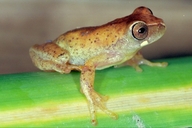|
Description
Dendropsophus werneri is a small species whose females measure up to 22 to 23 mm in SVL. Males are typically smaller in length, 18 to 20 mm (Lutz 1973). The head is short with large protuberant eyes. The snout is short and rounded, but juts out slightly in cross-section. The canthus rostralis is distinct. The tympanum is visible, and is about two-fifths the diameter of the eye. Vomerine teeth are present in two small groups located between the choanae (Lutz 1973). Both fingers and toes are webbed. Webbing between fingers is approximately one-third the length of the digits, and the webbing between toes is approximately three-fourths to almost the entire length (Duellman 1970; Lutz 1973). Hind limbs are relatively short. There are no dermal folds on the limbs, but they do possess an axillary membrane. The ends of D. werneri digits terminate in expanded discs. Males have a small ridge on the outside of their first finger, though they lack nuptial pads. Males have single large median subgular vocal sacs. The dorsal skin texture is smooth with occasional pustules. The ventral skin and lower median area of the thighs are granular (Lutz 1973). The dorsum is generally cream to tawny in color with small brown aggregated markings. Some individuals have a grayish red dorsal surface and a rosy ventral surface with a yellow belly. Dorsal markings can occur in an elongated X-shaped pattern, or the entire dorsal surface may be covered with dark spots, or it may be nearly devoid of pattern, which is typical for pale specimens. The sides of the head have a dark patch, and dark patches of dots are usually present on the knee and elbow. The visible portion of the thigh has short bars, while the concealed part of the thighs lacks patterning. Many individuals have vivid white spots below each eye, or occasionally under only one eye (Lutz 1973). The tadpoles have tails that narrow sharply into a flagellum-like appendage (Duellman 1970). Distribution and Habitat
Country distribution from AmphibiaWeb's database: Brazil
Dendropsophus werneri is common in southern and southeastern Brazil. It is mostly located in lowlands but can be found up to 800 m above sea level. Its habitat is limited to areas of vegetation near bodies of water (Andrade et al. 2004).Life History, Abundance, Activity, and Special Behaviors
This species is found near bodies of water, including flooded areas and abandoned agricultural fields. It can be located on the perimeter of forests during breeding season, but usually stays away from the interior of the forest. It tends to favor semi-permanent bodies of water, such as swamps, for breeding (Andrade et al. 2004). Dendropsophus werneri is a member of the Dendropsophus microcephalus group, which are known to breed in flooded areas during periods of high precipitation. Males of this group prefer to make their mating calls in low vegetation, such as grass or bushes. Eggs are laid on the water’s surface in small clusters, typically attached to aquatic-growing plants. In Brazil, adult members of this group are most commonly a form of arboreal species, but do not venture very high in trees when they do climb. Lutz (1973) found male D. werneri sitting atop herbaceous vegetation. Mating calls are reminiscent of an insect, occurring in a series: "creek-eek-eek-eek." The first sound is the primary note, followed in quick succession by repetitive secondary notes (Duellman 1970). The call of D. werneri was observed to be very similar to that of D. meridianus (then referred to as Hyla misera meridiana) (Lutz 1973). Trends and Threats
The species appears to be abundant (Andrade et al., 2004).[3900] Comments
This species has undergone numerous name changes since it was first described in 1894 by Werner (1894)[4001] as Hyla pygmaea. It was later renamed after Werner as Hyla misera werneri (Cochran 1952). The name was changed to its current form, Dendropsophus werneri, in 2005 (Faivovich et al. 2005).
References
Andrade, G., Bertoluci, J. and Conçalves da Cruz, C. A. (2004). Dendropsophus werneri. In: IUCN 2007. 2007 IUCN Red List of Threatened Species. www.iucnredlist.org. Downloaded on 05 October 2007.
Cochran, D.M. (1952). ''Two Brazilian Frogs: Hyla werneri, n. nom. and Hyla similis n. sp.'' Journal of the Washington Academy of Sciences, 42(2), 50.
Duellman, W.E. (1970). The Hylid Frogs of Middle America. Monograph of the Museum of Natural History, University of Kansas.
Faivovich, J., Haddad, C. F. B., Garcia, P. C. A., Frost, D. R., Campbell, J. A., Wheeler, W. C. (2005). ''Systematic review of the frog family Hylidae, with special reference to Hylinae: phylogenetic analysis and taxonomic revision.'' Bulletin of the American Museum of Natural History, (294), 1-240. [link]
Lutz, B., and Lutz, G. A. (1973). Brazilian Species of Hyla. University of Texas Press, Austin and London.
Werner, F. (1894). ''Herpetologische Nova.'' Zoologischer Anzeiger, 17, 410-415.
Originally submitted by: Vanessa Lovenburg (first posted 2007-10-19)
Edited by: Kellie Whittaker (2007-11-26)Species Account Citation: AmphibiaWeb 2007 Dendropsophus werneri <https://amphibiaweb.org/species/6467> University of California, Berkeley, CA, USA. Accessed May 30, 2025.
Feedback or comments about this page.
Citation: AmphibiaWeb. 2025. <https://amphibiaweb.org> University of California, Berkeley, CA, USA. Accessed 30 May 2025.
AmphibiaWeb's policy on data use.
|




 Map of Life
Map of Life